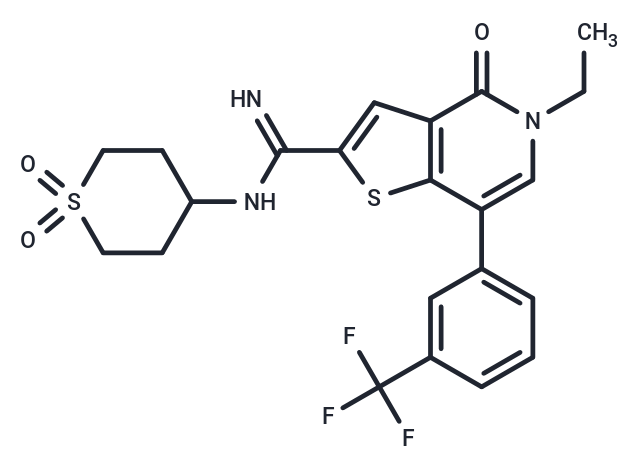Shopping Cart
Remove All Your shopping cart is currently empty
Your shopping cart is currently empty
I-BRD9 (GSK602) is the first selective cellular inhibitor for BRD9 with pIC50 of 7.3.

| Pack Size | Price | USA Warehouse | Global Warehouse | Quantity |
|---|---|---|---|---|
| 1 mg | $34 | In Stock | In Stock | |
| 2 mg | $47 | In Stock | In Stock | |
| 5 mg | $68 | In Stock | In Stock | |
| 10 mg | $115 | In Stock | In Stock | |
| 25 mg | $227 | In Stock | In Stock | |
| 50 mg | $433 | In Stock | In Stock | |
| 100 mg | $642 | In Stock | In Stock | |
| 1 mL x 10 mM (in DMSO) | $76 | In Stock | In Stock |
| Description | I-BRD9 (GSK602) is the first selective cellular inhibitor for BRD9 with pIC50 of 7.3. |
| Targets&IC50 | BRD9:7.3 (pIC50) |
| In vitro | I-BRD9 is identified through structure-based design, leading to greater than 700-fold selectivity over the BET family and 200-fold over the highly homologous bromodomain-containing protein 7 (BRD7). I-BRD9 is used to identify genes regulated by BRD9 in Kasumi-1 cells involved in oncology and immune response pathways and to the best of our knowledge, represents the first selective tool compound available to elucidate the cellular phenotype of BRD9 bromodomain inhibition[1]. |
| Kinase Assay | Receptor binding is performed using membranes prepared from cells with recombinant expression of adenosine receptors as follows: human A2A and HEK 293, rat A2A and Chinese hamster ovary, human and rat A1 and Chinese hamster ovary, and human A3 and HEK 293. Radioligand competition binding assays are performed in 96-well plates in a total assay volume of 200 μL using a final test drug concentration range of between 0.1 and 3 μM. Membranes are diluted in assay buffer, pH 7.4 (A1 and A2A, Dulbecco's phosphate-buffered saline with 10 mM MgCl2; A3, 50 mM Tris-HCl, 120 mM NaCl, 10 mM MgCl2). To remove endogenous adenosine from the membrane preparations, 4 U/mL adenosine deaminase is added to the membranes, which are then incubated at room temperature for 15 min. Radioligand is added to a final concentration of 0.5 ([3H]SCH 58261, A2A), 1 ([3H]DPCPX, A1), or 0.25 ([125I]AB-MECA, A3) nM. Nonspecific binding is defined by adding 100 nM CGS 15923 (A2A), 100 nM NECA (A1), or 100 nM DPCPX (A3). Plates are incubated at room temperature with agitation for 1.5 h (A2A and A1) or 2 h (A3). Membranes are filtered onto Packard GF-B filter plates and washed in ice-cold assay buffer using a Brandel cell harvester to separate bound and free radioligand. The plates are dried before addition of 45 μL of Microscint 20 to each well. |
| Synonyms | GSK602 |
| Molecular Weight | 497.55 |
| Formula | C22H22F3N3O3S2 |
| Cas No. | 1714146-59-4 |
| Smiles | CCn1cc(-c2cccc(c2)C(F)(F)F)c2sc(cc2c1=O)C(=N)NC1CCS(=O)(=O)CC1 |
| Relative Density. | 1.50 g/cm3 (Predicted) |
| Storage | Powder: -20°C for 3 years | In solvent: -80°C for 1 year | Shipping with blue ice/Shipping at ambient temperature. | |||||||||||||||||||||||||||||||||||
| Solubility Information | DMSO: 50 mg/mL (100.49 mM), Sonication is recommended. | |||||||||||||||||||||||||||||||||||
| In Vivo Formulation | 10% DMSO+40% PEG300+5% Tween 80+45% Saline: 1 mg/mL (2.01 mM), Sonication is recommended. Please add the solvents sequentially, clarifying the solution as much as possible before adding the next one. Dissolve by heating and/or sonication if necessary. Working solution is recommended to be prepared and used immediately. The formulation provided above is for reference purposes only. In vivo formulations may vary and should be modified based on specific experimental conditions. | |||||||||||||||||||||||||||||||||||
Solution Preparation Table | ||||||||||||||||||||||||||||||||||||
DMSO
| ||||||||||||||||||||||||||||||||||||
| Size | Quantity | Unit Price | Amount | Operation |
|---|

Copyright © 2015-2025 TargetMol Chemicals Inc. All Rights Reserved.